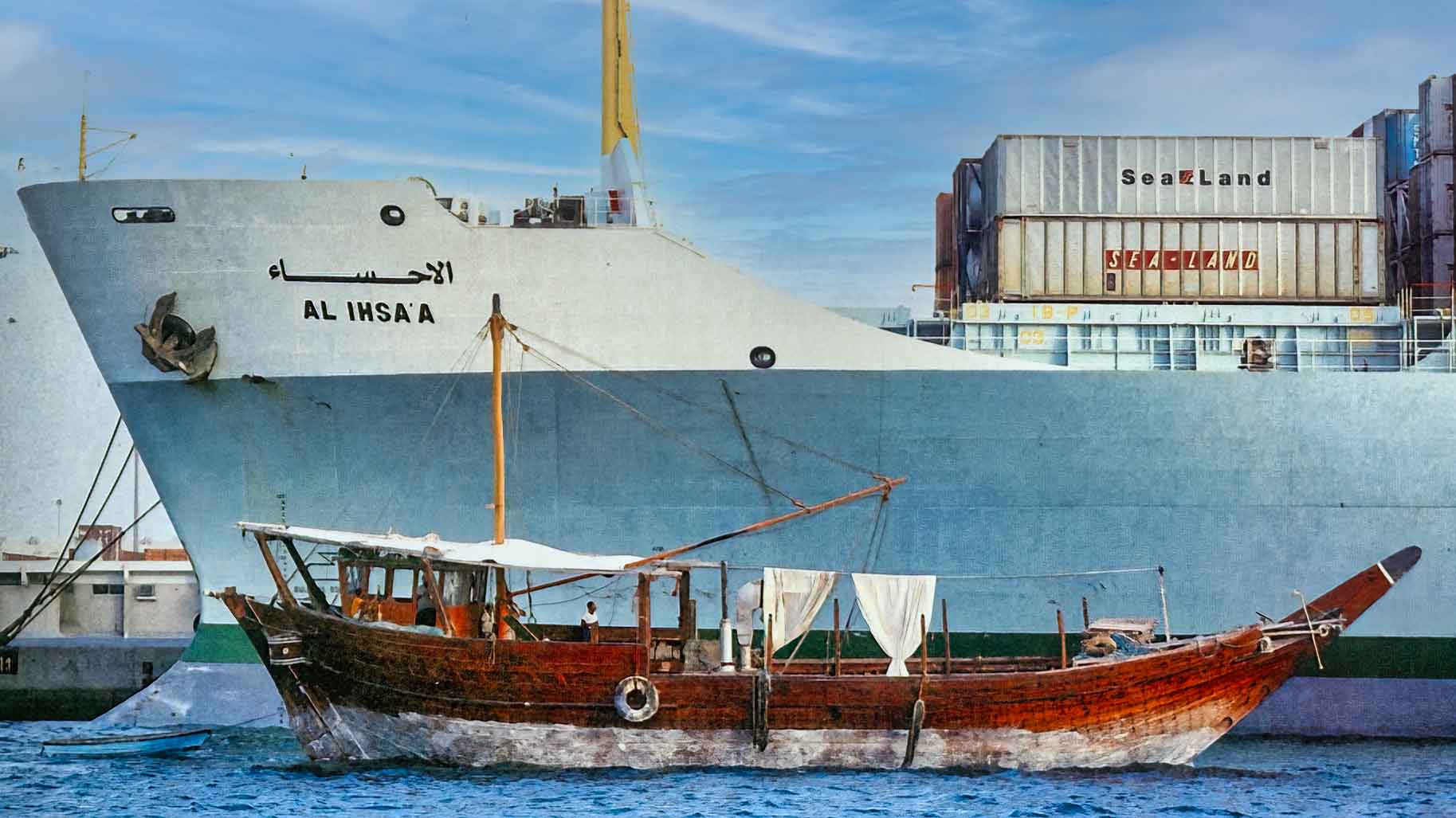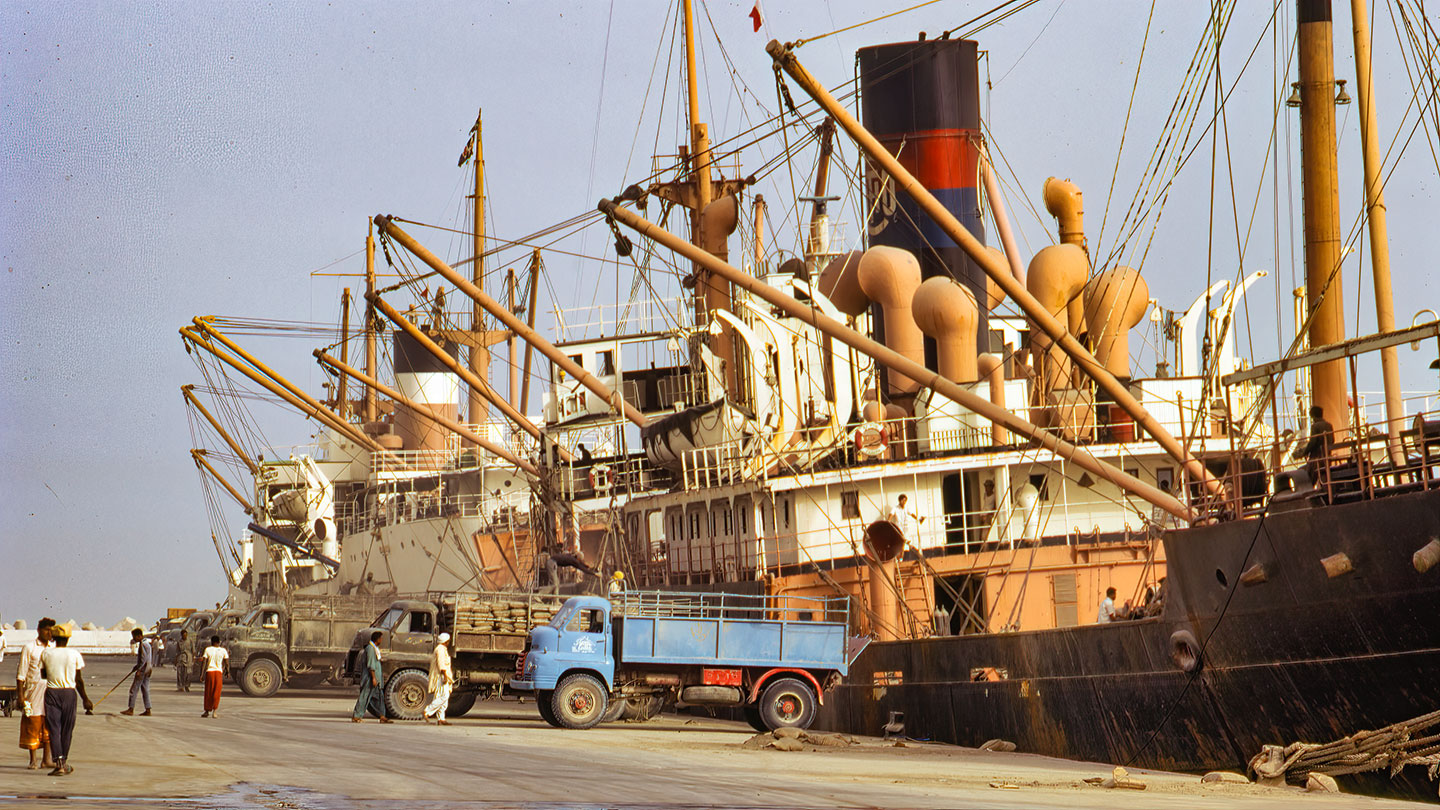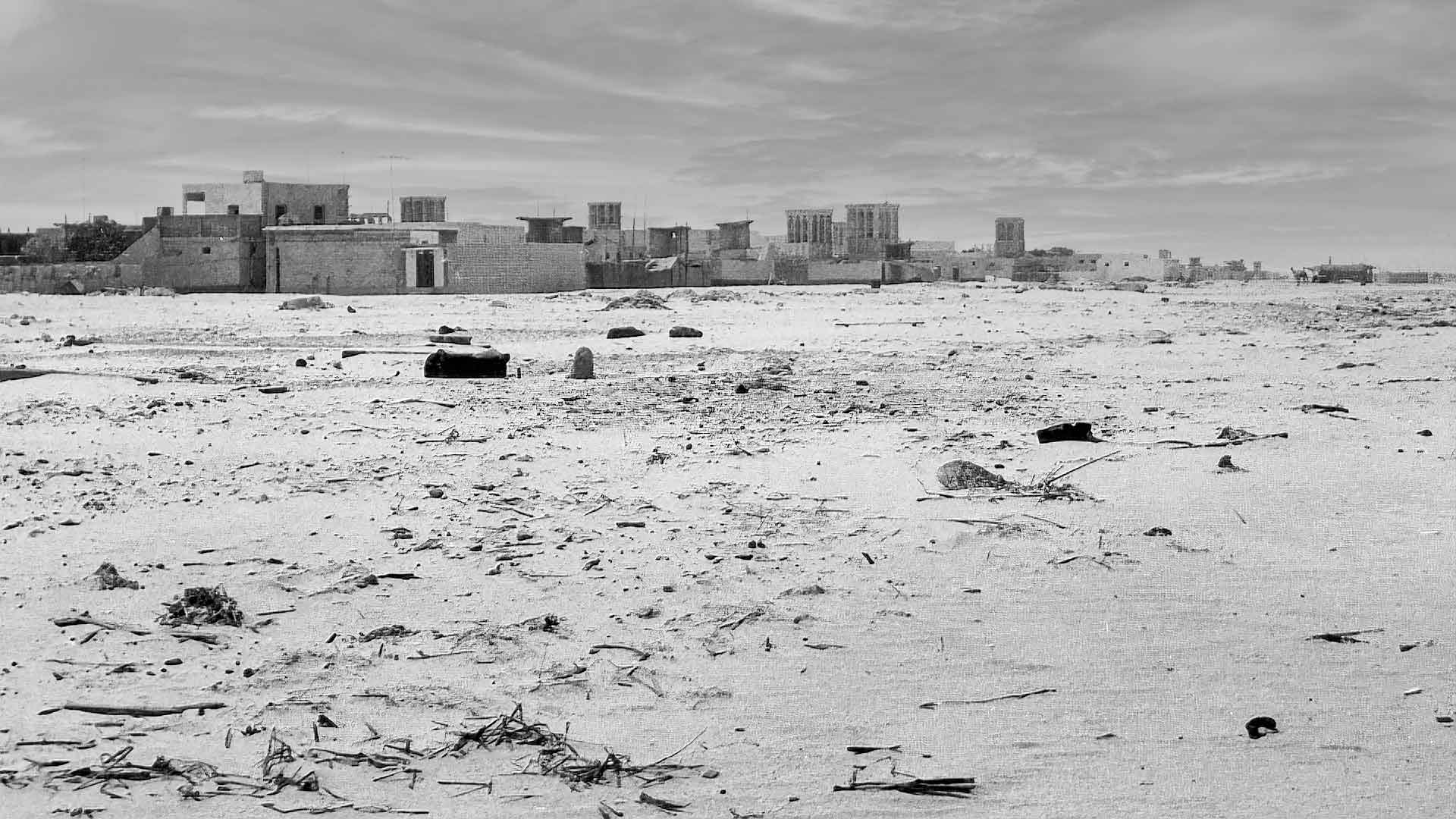
Shindaga 1968
Port Rashid 1959-1980
Sheikh Rashid formed his ambition to turn Dubai into a major Trade Centre as long ago as 1959.
In 1959, John Harris (Architect) was appointed by Sheikh Rashid to develop a Dubai Town Plan
The Dubai Town Plan (1959)4provided for a four berth port located at Shindaga
Sheikh Rashid was a step closer to realising his long held ambition of a Deep Water Port.
In 1965 Sheikh Rashid instructed Sir William Halcrow & Partners to design a Port. Their proposal was for a four berth Port built on reclaimed land at Shindaga.
Dredging was to provide deep water with dredged material used to construct berths, storage areas etc.
Shindaga had been the traditional home of Dubai's Ruling Al Maktoum Family
In 1967, Dubai found oil offshore so now Sheikh Rashid could finance his deep water port
Clearing the Way
A large area of Shindaga was vacated to make way for Port Rashid Construction Works.
Image show empty properties with Costain's Stabit Production line in the background.
Stabit were to play a crucial role in protecting Port Rashid's breakwaters from erosion by the sea.
In the distance at sea is a British Navy Mine Sweeper, anchored off the entrance to Dubai Creek. Dubai was still part of the Trucial States in 1968.
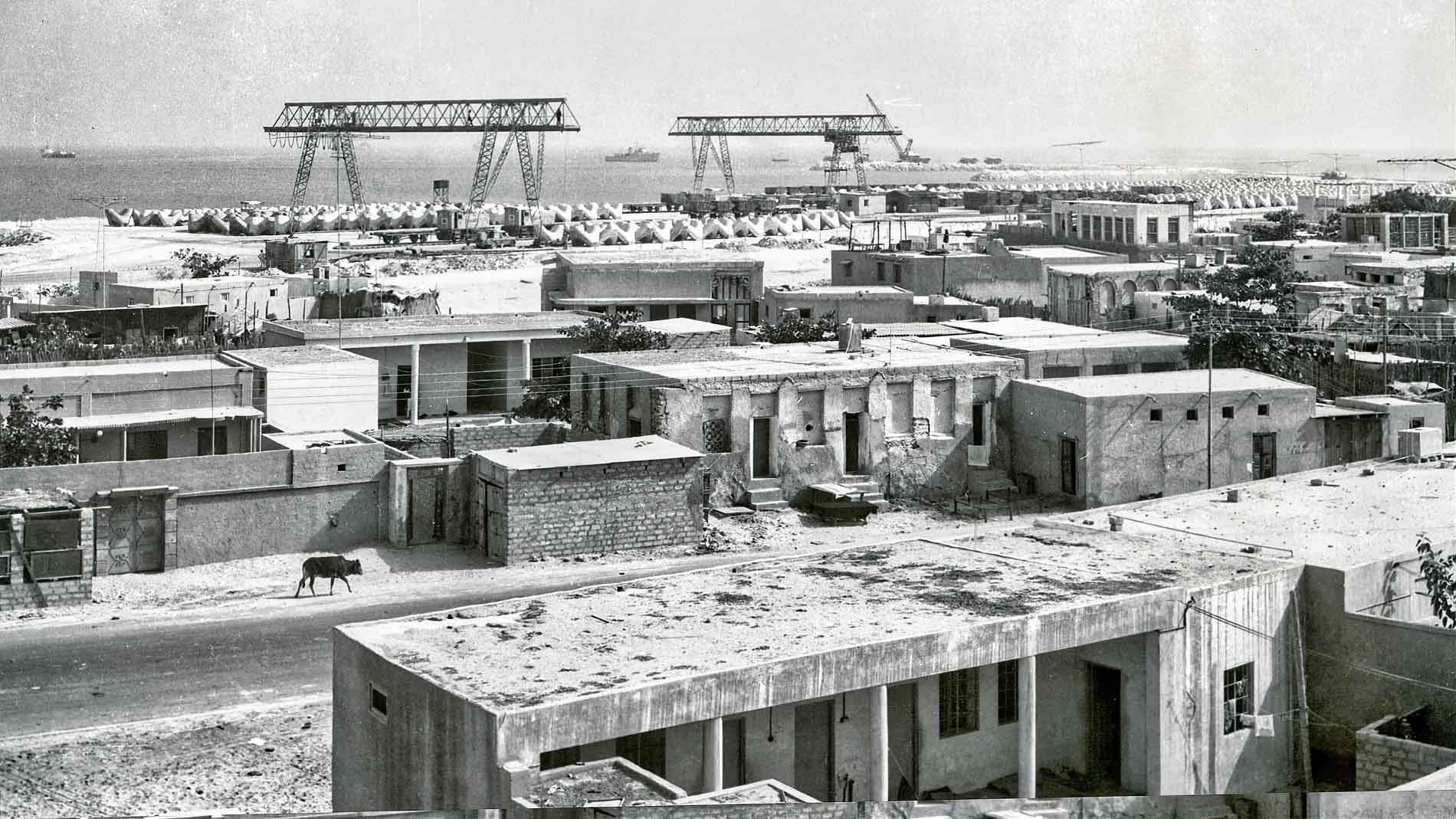
Bigger is Better!
Halcrow's design provided four berths, Passenger Terminal, a Restaurant plus Workshops and Offices.
Sheikh Rashid soon had doubts as to whether Port Rashid could meet Dubai's future needs.
Several months into the project, Sheikh Rashid ordered Port Rashid's design to be changed from 4 Berths to 15 Berths. His Advisors thought 15 Berths too many and too costly.
Sheikh Rashid dealt with the cost element by removing everything he considered unnecessary from the design
That included Passenger Terminal, Restaurant, Offices and Workshops
Sheikh Rashid now considered the project to be affordable.
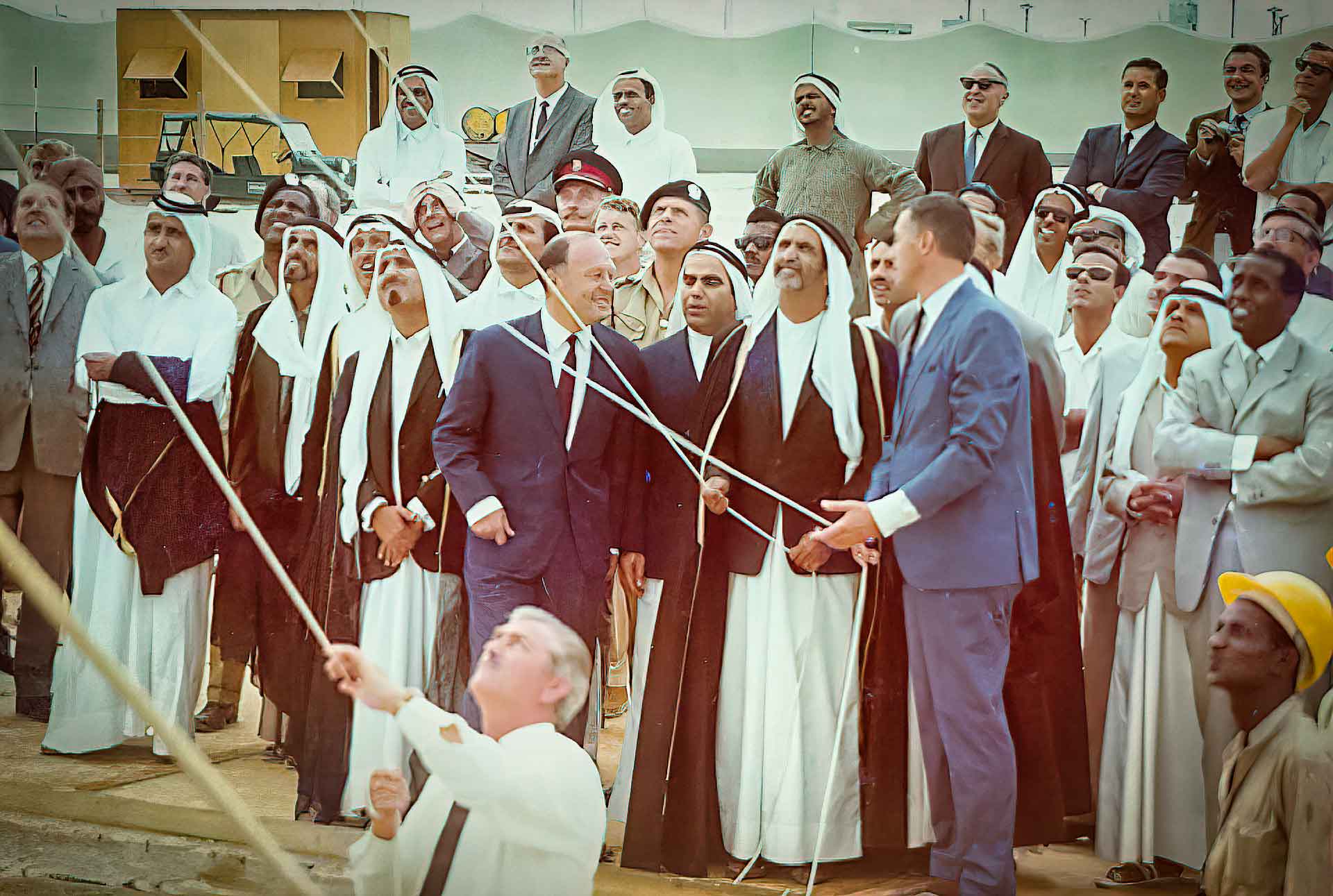
Sheikh Rashid Driving the first Pile © Ludwig Hejze
Who will Manage and Operate Port Rashid?
With Port Rashid's construction underway, the question became "Who will manage and operate Port Rashid?".
Sheikh Rashid did not want a new Government Bureaucracy. He understood Port Rashid needed to outperform other Regional Ports if Dubai was to become "The" Regional Trade Centre. He wanted a private Contractor and turned to George Chapman, Managing Director Gray Mackenzie and Co. George was one of Sheikh Rashid's trusted Advisors. His company represented International Shipping Agencies and operated Dubai's tug and barge cargo operation since early 1950s. Back then ocean-going ships anchored off Dubai and discharged their cargoes into barges. Gray Mackenzie and Co owned and operated these tugs and barges. Sheikh Rashid asked George to make a proposal for managing and operating Port Rashid.
Sheikh Rashid's Majlis was against appointing a foreign owned company (Gray Mackenzie was then part of UK's Inchcape Group). Another Sheikh Rashid Advisor, Mahdi Tajir, produced a counter proposal. It took a year of negotiations before Sheikh Rashid awarded the Contract to Gray Mackenzie and Co. Gray Macs established a new company, Dubai Port Services, to manage and operate Port Rashid.
Gray Macs recruited a Port Manager and a Harbourmaster from East African Railways and Harbours Board and a Port Engineer from Bahrain's Department of Ports and Customs. As part of their agreement with Sheikh Rashid, Dubai Port Services employed all Dubai Customs Staff working in Dubai Creek Customs Area and purchased all Government owned cargo handling plant.
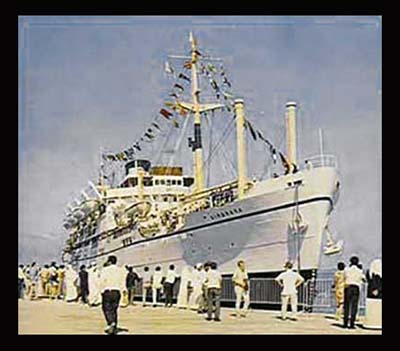
First Ship to Officially Berth at Port Rashid
Port Rashid officially handled its first ship in November 1980.
Captain Arthur Jarman piloted British India Shipping Line's mv Sirdhana alongside at No.3 Berth
Berth 3 the only completed berth at that time.
British India Shipping Line passenger ships regularly called to Port Rashid.
Port Rashid formally opened
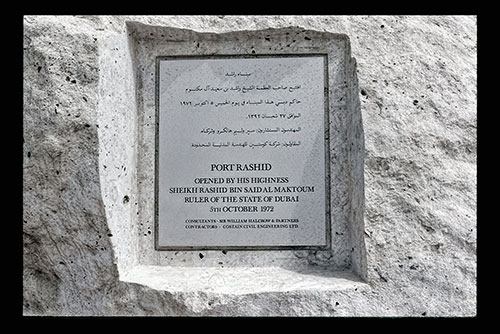
Sheikh Rashid formally opened Port Rashid on 5th October 1972. By then thousands of tonnes of construction materials and cargoes had flowed through Port Rashid. Sheikh Rashid unveiled a Commemorative Plaque set in a large rock symbolising Sheikh Rashid's personal role in identifying suitable rock source at Badiyat for Port Rashid's construction. Using local rock instead of imported rock saved millions of Dirhams in construction costs.
Port Rashid had a profound effect on Dubai's development. Materials were now easily imported. Construction Projects moved ahead. Dubai started attracting trade away from other Gulf areas plus new international business. Sheikh Rashid played a part in this growth. In 1973, Organization of Arab Petroleum Exporting Countries declared an Oil Embargo on USA and other Nations. Result was an International Crisis. Ships and Airplanes were refused refuelling at Arab Seaports and Airports. Dubai publicly expressed support for the embargo. Privately Sheikh Rashid ordered Port Rashid to refuel any ship wanting to do so whatever its nationality. Word spread among international shipping lines. Ships of all Nationalities began radioing Port Rashid to ask for bunker fuel. right were turned away. OAEPEC's Oil Embargo was lifted after 6 months. By then Port Rashid had become an internationally known port.
The Downside
Port Rashid's Tariff had been set by Dubai Government with Sheikh Rashid's approval.
It favoured local Merchants by providing extended free cargo storage periods and low penalty rates for cargo left in the port after free period expired. As a result Merchants found it cheaper to leave their goods in Port Rashid until it suited them to remove it. Result was Port Rashid's storage sheds and yards became clogged with cargo as increasing amounts of cargo arrived but little left the Port.
Soon Port Rashid ran out of storage space for incoming cargoes. That meant ships queued offshore until storage space could be found to store their cargoes. At its peak over 200 ships anchored off Dubai waiting to unload their cargoes.
Average Waiting Time was four months. Cargo rates rose as a consequence. Importing goods into Dubai became increasingly expensive and threatened Dubai's growth.
Port Rashid 1972-1980
Changing the Rules
Port's Management wanted its Tariff changed. Local Merchants did not - they had nowhere to store their goods- they said.
Sheikh Rashid realised this impasse was impacting on Dubai's development. He ordered low cost storage sheds to be built outside Port Rashid which he then leased to the Merchants. He revised Port Rashid's Tariff reducing free storage periods and increasing storage penalty rates That made it expensive for Merchants to leave their goods stored in Port Rashid for any extended period.
But the damage had been done. Long delays had changed the way Shipping Lines were transporting cargoes to Dubai
Those changes impacted on how these cargoes were handled at Port Rashid.
Cargoes shipped in Old Boxes
Ships starting arriving with some of their cargo carried in old Shipping and Railway Containers lashed onto their decks.
Port Management started giving these ships priority discharge simply because these containers could be unloaded easily and the berth cleared quickly for the next ship.
As more shipping lines saw the benefit of carrying containers on deck then more ships arrived with containers. Shipping Lines didn't mind leaving these old containers behind. At the same time Containerisation was developing between US, Europe, Asia and Australian Ports.
Conventional wisdom was containerisation was not suitable for the Gulf since since there were no export cargoes to fill returning Containers. This made using containers commercially not viable was the prevalent view.
This thinking did not take did not account losses shipping companies incurred from their ships waiting up to four months to discharge or the increasing availability of cheap disposable shipping containers. Also much of the cargo carried into Dubai was Premium Cargo for major projects.
Shipping Lines could charge high rates for these cargoes which offset and subsidised the return voyage.
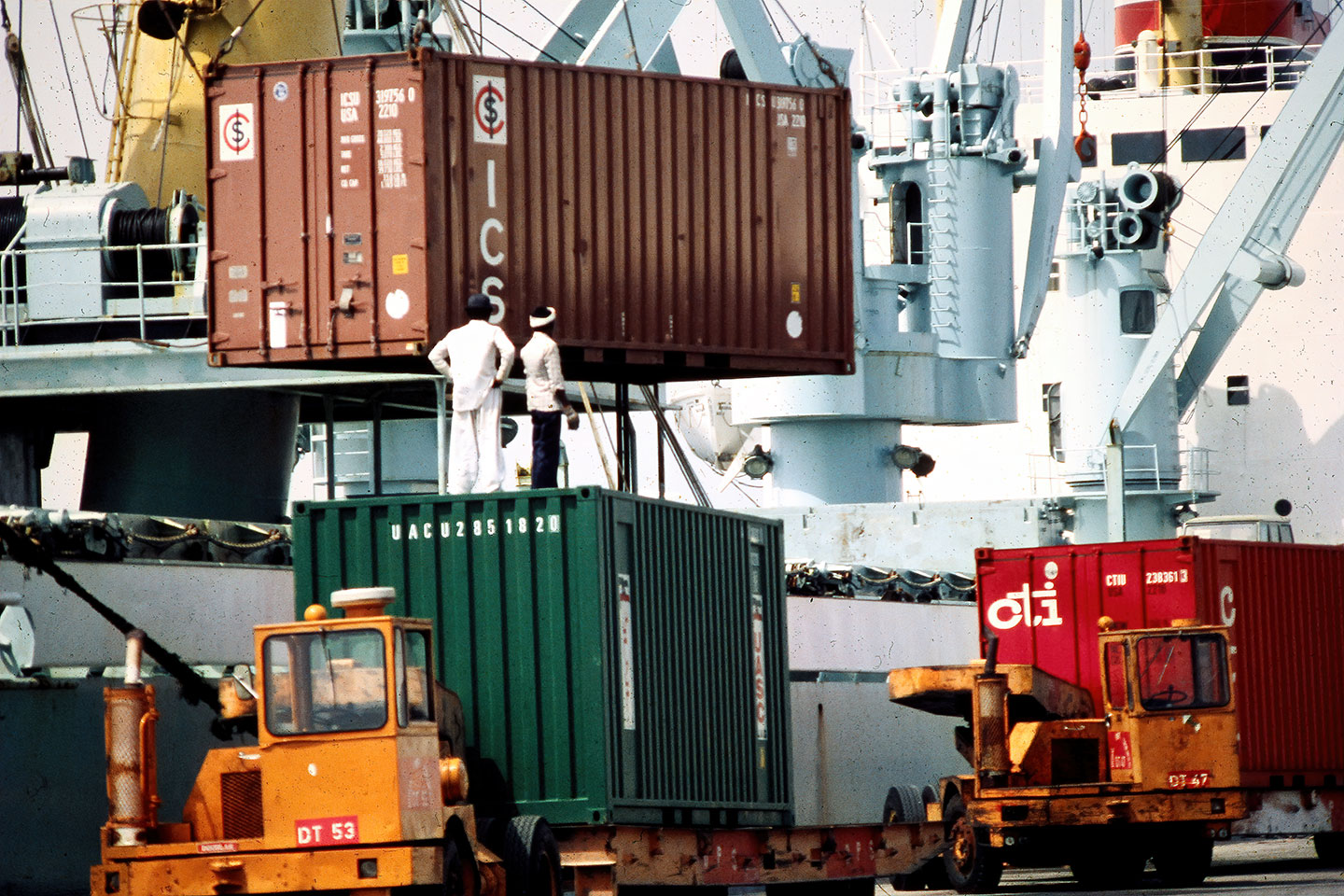
Port Rashid 1980-1990
In barely 8 years since Port Rashid formally opened Port Rashid had become a world class Container Terminal known internationally.
1980 was the start of a period of unprecedented growth. Sheikh Rashid's vision of Dubai as an International Trade Centre became reality but by May 1981 Sheikh Rashid had become ill. He never fully recovered or ruled again. His sons collectively assumed Sheikh Rashid's roles. Sheikh Rashid's contract with Dubai Port Services made DPS solely responsible for Port Rashid's management, operation and development. In return, Sheikh Rashid received a substantial share of DPS's profits. Many ports worldwide operate on a similar basis today.
In 1971 this Public/Private Partnership was unique. But DPS was seen by many in Dubai Government as a foreign company controlling Dubai's major port and sending profits overseas. Sheikh Rashid's control weakened after his illness. Some members of Dubai Government attempted to terminate DPS's contract.
This led to increasing uncertainty in Dubai's Merchant and Shipping Communities before Sheikh Mohammed stepped in to resolve the situation.
Changing Names
Sheikh Mohammed took control of Ports and Customs in 1984.
He negotiated a new contract with Gray Mackenzie and Co. They became Port Managers on a fee earning basis related to Port Performance. Dubai Government took over financial and investment control. "Port Rashid Authority" replaced Dubai Port Services. "Port Rashid Authority" was the name under which Gray Mackenzie operated their management contract. "Port Rashid Authority" was never legally established as a private company or a Government Authority.
Sheikh Mohammed's solution overcame the immediate problem. Port Rashid continued to operate and grow. This new management arrangement brought its own problems. Containerisation needs specialised Plant and Machinery. Port Rashid's increasing container throughputs meant more investment in Plant and Machinery was needed to maintain handling efficiencies. Investment was now controlled by Dubai Government.
Their processes were governmental and not commercial. Their processes were slow and didn't understand commercial realities. Investment was not forthcoming. Port Rashid faced handling increasing container throughputs without the corresponding increase in Plant and Machinery.
Port Rashid struggled to maintain handling efficiency throughout the 1980s. In doing so they achieved industry high levels of plant usage and availability primarily through the use of modern technologies and dedicated staff.
Port Authority of Jebel Ali (PAJA)
Sheikh Rashid appointed Sealand Shipping Company to manage and operate Jebel Ali Port on a similar basis to Dubai Ports Services. Sheikh Rashid conceived Jebel Ali Port as an industrial port. His expectation was Industry would develop around the port. That didn't happen. Jebel Ali Port was not initially successful. Two factors worked against Jebel Ali Port.
- Dubai's Merchants regarded Jebel Ali Port as too far out of town. They preferred Port Rashid. It was close to their warehouses and offices.
- Sealand Shipping Company was an American Shipping Line. Sealand SC tried to attract other shipping lines to Jebel Ali Port. At the same time they competed with their prospective customers for the same shipping business. Consequently Shipping Lines treated Jebel Ali Port with suspicion. Only a small number of shipping lines moved to Jebel Ali Port.
By 1990 Dubai Government faced a situation where:
- Two ports serving Dubai were competitors chasing the same business.
- Port Rashid was an established success with high throughputs. Jebel Ali Port had very low throughputs.
- Port Rashid needed substantial investment for expansion but lacked space. Jebel Ali Port had under utilised land and berths.
Dubai Government resolved this situation by:
- Terminating Management Contracts in both ports
- Establishing a new independent Government owned commercial entity called "Dubai Ports Authority"
- Dubai Ports Authority employing all the staff previously employed by Port Rashid Authority and Port Authority of Jebel Ali
- DPA managing both ports as a single port
- Making significant investments in both ports
These changes laid the basis for Dubai's Ports to develop into one of the World's Leading Container Terminals and ultimately a Leading International Container Terminal Operator
Port Rashid formally closed in 2008 except for Cruise Ship operations.
By then Maritime City had developed between Port Rashid and Dubai Drydocks.
Land started to be reclaimed in Port Rashid for property development.
Now people will be living where Dubai established its reputation as an International Trading and Business Centre.
Port Rashid's closure brought an end to a significant era in Dubai's development.
36 years after Sheikh Rashid formally opened Port Rashid,
this key element in Dubai's success closed as a commercial cargo port.
Port Rashid is to become a Residential Development and Cruise Terminal.

